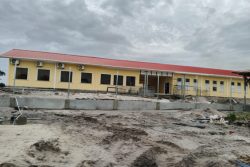The following table shows an outline of each of the recommendations proposed by the food committee that financial aid has been sought for.
“Recommendations
“1. To transform the GSA farm into a model demonstration farm. This will involve the redesigning of farm buildings and acquisition of equipment and other inputs necessary for the transformation of the model farm.
“2. Farmers’ Field Schools to be expanded countrywide. Currently, there are approximately 16 FFSs. Coverage will be increased in Regions 2,3,5 and 6 for a total of approximately 30 FFSs.
“3. Development of other crops for feed and substitute products. NARI will acquire and screen varieties for possible adaptation to local conditions.
“Crops will include corn, soybean, sorghum, red peas, pigeon peas, black eye peas, kidney beans. In addition NARI will begin acquiring and propagating high yielding varieties of cassava.
“4. To collaborate with GRDB and Guysuco in the use of foliar analysis techniques to determine fertilizer application rates in rice production (Held trials and laboratory analysis).
“5. NARI and GSA will collaborate with research on composite flours and utilizing other ingredients in combination with wheat flour.
“6. Enhance the extension services which are ongoing in all 10 Regions. Forty-three (43) extension staff were hired and an additional forty-seven (47) are being hired for a total of ninety (90) extension workers.
“7. Collaboration with NARI to encourage the use of locally grown materials for feed. This will be done via seminars, workshops, demonstrations in various regions and meeting with feed manufacturers and other stakeholders to indentify short term interventions.
“8. The development of a mechanism for the monitoring of the quality of feed and the health of baby chicks. This involves liaising with Guyana National Bureau of Standards to develop standards to ensure quality is enforced at hatcheries.
“9. Strengthening capacity to produce safe wholesome meat through the mobilisation of stakeholders for the establishment of abattoirs of international standards and training or measures such as Hazard Analysis and Critical Control Point (HACCP).
“10. The identification of some farmers that will increase their production through technical support. The MOA and partners are working with a group at Dartmouth and in the Intermediate Savannas to aid technology transfer and provide access to new technologies such as improved husbandry and green house shelters.
“11. Encourage sustained production for local consumption in the hinterland and linkages with mining companies. Training seminars, research and materials, training in Acoushi ants control and awareness seminar with mining companies and the marketing of produce to these companies will be explored.
“12. Expand cultivation of other crops including an Orchard Programme, The transfer of technology, demonstration, extension activities and acquiring of planting materials will be done as well as establishment of nurseries.
“13. To encourage production of fish by-products through seminars and workshops involving all stakeholders.
“14. To investigate the use of aqua weeds in aqua culture.
“15. To make available to the Ministry of Amerindian Affairs, when necessary, assistance in the transportation of foodstuff to the Hinterland.
“16. Support to the National Dairy Development Programme (NDDP) in efforts to utilize indigenous material in the formation of feedstuff for ruminants.
“17. Encourage communities to form ‘Buying clubs’ nationwide to reduce cost (NGMC can assist).”
The report was adopted in the National Assembly on June 10, 2010.








